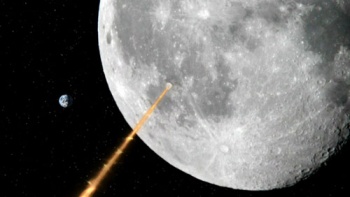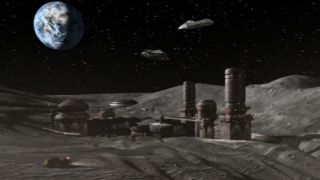Luna
Planetary Data
| Official Name: | Lunar Colonies[1] |
| Affiliation: | United Earth Republic,[2] United Federation of Planets[3] |
| Astrography: | Sol IIIa,[3] Sol Sector (Sector 001),[4] Alpha Quadrant[1] |
| Distance from Star: | 1 AU / 149,680,000km[1] |
| Distance from Planet: | 384,500km[1] |
| Orbital Period: | 27.3 days[1] |
| Rotational Period: | 27.3 days[1] |
| Class: | D[1] |
| Surface Temperature: | -155°C to 105°C[1] |
| Diameter: | 3476km[1] |
| Gravity: | 0.16g[1] |
| Natural Satellites: | Luna is the sole moon of Earth[3] |
| Points of Interest: | Tycho City,[5] New Berlin,[6][5] Lake Armstrong,[5] Lunaport[1] |
| Notable Species: | Humans[5] |
| Notable Events: | Apollo 11 landing[7] |
Founded in 2039,[1] the Lunar Colonies were home to more than 50 million people in the late 24th century,[5] and light from lunar cities was visible from space[8] and, on a clear day, the surface of Earth.[5] In 2254, the Talosians downloaded the information in the Starship Enterprise's computers, including data on the Moon and Human exploration of the world.[3]
FASA Timeline
The first permanent base on the moon, jointly funded by the United States of America and Japan, was established on 18 April 1997. This marks the rededication of humanity to space exploration as part of the rebuilding following the Eugenics Wars.[9] Goddard Moonbase, the first large-scale international space project, was officially established the following year, and provided accommodations for 70 in the fields of space research and industry.[10] In 1999, several more lunar stations were opened by various nations and several private corporations. Armstrong Center, remaining the largest, became a small city of scientists, technicians, and support personnel, and already beginning to cater to a growing tourist trade.[9]
The Science Council of Luna declared itself independent of the governments of the United States of America and Japan on 1 January 2001, and requested status as a United Nations protectorate. The request was granted, forming the first interplanetary Human government.[9] The United Space Initiative, which focused and accelerated man's exploration of the Solar system for the benefit of all mankind, was signed in New York on 15 October 2003.[10] As part of the Initiative, the United Nations Space Force was created, and several installations for the service were constructed over the next three years, including a base on the moon..[11]
In 2004, the first major expansion of the Goddard Moonbase occured. Also that year, Farside Moonbase began operations, specializing in radio telescope observations. The first child born in space was born a year later at Farside Moonbase to Radio Telescope Technician 1st Class Rita Ashworth and Dr. Weldon Ashworth of the Astro-Telemetry Section; the parents named their son Jules, after the famous science-fiction writer, Jules Verne, who first envisioned Human exploration of the moon. The event was heralded the world over as "a new generation of man has begun." Thomas Morrison, the first person to die on the moon, was buried in a simple grave marking the historic occasion in 2006. On the 50th anniversary of the first manned mission to the moon, all six original Apollo landing sites officially became protected historic landmarks.[10]
References
- ↑ 1.00 1.01 1.02 1.03 1.04 1.05 1.06 1.07 1.08 1.09 1.10 1.11 "Star Trek: Star Charts". Star Trek (Miscellaneous). Book. Simon & Schuster/Pocket Books, October 2002.
- ↑ "Broken Bow". Enterprise, episodes 01-02. Television. Paramount Pictures Corporation, 26 September 2001.
- ↑ 3.0 3.1 3.2 3.3 "The Cage". Star Trek, episode 0. Television. Desilu Studios, 1965 (Unaired).
- ↑ "The Best of Both Worlds, Part II". Star Trek: The Next Generation, episode 175. Television. Paramount Pictures Corporation, 24 September 1990.
- ↑ 5.0 5.1 5.2 5.3 5.4 5.5 Star Trek: First Contact. Film. Paramount Pictures Corporation, 22 November 1996.
- ↑ "Descent". Star Trek: The Next Generation, episode 252. Television. Paramount Pictures Corporation, 21 June 1993.
- ↑ "Tomorrow is Yesterday". Star Trek, episode 21. Television. Desilu Studios, 26 January 1967.
- ↑ "Will You Take My Hand?" Star Trek: Discovery, episode 15. Television/Streaming. CBS Entertainment, Inc., 11 February 2018.
- ↑ 9.0 9.1 9.2 Wheeler, Wm. John with McLimore, Guy W. Jr., Poehlein, Greg K., and Tepool, David F. "Cadet's Orientation Sourcebook." Star Trek: The Role Playing Game, Book 2004A. FASA Corporation, 1983.
- ↑ 10.0 10.1 10.2 Goldstein, Stan and Goldstein, Fred with Sternbach, Rick. Star Trek: Spaceflight Chronology. Pocket Books, 1980.
- ↑ Theisen, John A. "Star Fleet Intelligence Manual: Agent's Orientation Sourcebook." Star Trek: The Role Playing Game, Supplement 2014B. FASA Corporation. 1987.

